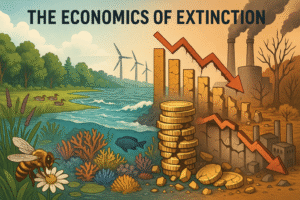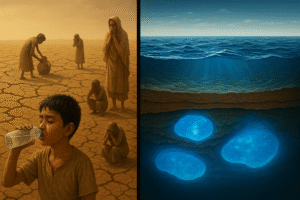Fun Fact: Did you know sustainable tourism is worth over $700 billion worldwide and continues growing as travellers seek greener, more ethical options?
Nowadays, more people are recognizing the significance of sustainable tourism and how it influences economic growth. Sustainable tourism isn’t just about eco-friendly travel—it’s a movement to protect and preserve the environment while supporting local communities and boosting economies. But how does it all work, and why should we care?
Sustainable tourism, at its heart, is about creating travel experiences that benefit the environment, culture, and economy of the destination. It goes beyond reducing the environmental impact of tourism by fostering responsible practices that ensure local communities thrive, protecting natural resources, and encouraging cultural respect. This article explores how sustainable tourism plays a significant role in economic development and what makes it essential for a better future.
The Connection Between Sustainable Tourism and Economic Development
Sustainable tourism contributes to economic growth in several ways, and its impact extends beyond preserving landscapes and wildlife. When done responsibly, sustainable tourism generates jobs, supports local businesses, and promotes infrastructure development, all of which are essential for economic growth.
Job Creation and Economic Opportunities
One of the most immediate benefits of sustainable tourism is its potential to create jobs. From tour guides and hotel staff to artisans selling local crafts, tourism brings new employment opportunities, often to rural and underserved areas. For example, Costa Rica, known for its eco-tourism model, has generated thousands of jobs by emphasizing its natural beauty and unique biodiversity. In doing so, it has increased the average income of local families, allowing many to escape poverty.
In addition, sustainable tourism creates entrepreneurial opportunities. Local businesses—whether they’re homestays, traditional handicraft stores, or organic farms—can flourish as tourists seek authentic and unique experiences. This influx of business and innovation boosts the economy while preserving the region’s cultural heritage.
Environmental Preservation: A Long-term Investment
Natural resources, once destroyed, take years or even centuries to recover. Sustainable tourism protects these resources, which are valuable economic assets in themselves. Take, for instance, the Galápagos Islands. With strict visitor regulations and preservation policies, the local economy thrives on tourism while ensuring the islands’ delicate ecosystems remain intact.
Investing in environmental preservation doesn’t only protect natural beauty; it also makes economic sense. By reducing the impact of human activity, sustainable tourism ensures that natural attractions can continue to generate revenue over the long term. Destinations that prioritize preservation often become attractive to conscientious travellers, further enhancing their economic potential.

Cultural Preservation and Community Empowerment
Sustainable tourism promotes the respect and preservation of local cultures. Unlike mass tourism, which can commercialize and dilute local traditions, sustainable tourism emphasizes the authenticity of cultural experiences. Japan’s village of Shirakawa-go, a UNESCO World Heritage site, is a prime example. The village carefully limits visitor numbers to ensure that traditional thatched-roof houses and customs are preserved. This controlled approach has helped the local economy by promoting responsible tourism, creating jobs, and empowering residents to maintain their cultural heritage.
Communities that feel empowered tend to engage more in tourism initiatives and are likely to invest in their future. By maintaining cultural integrity, communities foster pride and motivation, fueling further economic development and making tourism a sustainable income source.
Boosting Infrastructure and Basic Amenities
Infrastructure improvements, such as better roads, reliable public transport, and enhanced utilities, are often the by-products of tourism. When managed responsibly, these enhancements benefit both tourists and local communities. For example, Bhutan’s policy of “High Value, Low Impact” tourism ensures that revenue from tourism is reinvested in infrastructure that benefits citizens and tourists alike. Roads, airports, and public facilities are improved through tourism taxes, ultimately benefiting the nation’s economic and social landscape.
Such investments make destinations safer, more appealing, and accessible, helping to stabilize and grow the local economy. In turn, these improvements make the area attractive for future sustainable tourism, creating a cycle of economic and social benefits.
Real-Life Case Studies in Sustainable Tourism
To better understand sustainable tourism’s impact, let’s explore a few notable examples where these principles have driven economic growth.
Costa Rica: A Global Leader in Eco-Tourism
Costa Rica is celebrated as a pioneer in eco-tourism. By focusing on conservation and eco-friendly tourism practices, Costa Rica has built a multi-billion-dollar industry around its natural resources. Roughly 25% of its land is protected, including national parks, wildlife reserves, and protected areas. This strategy has preserved Costa Rica’s rich biodiversity and simultaneously boosted economic growth. Each year, the country draws millions of environmentally-conscious travellers, creating jobs and enhancing the quality of life for local residents.
Iceland: Promoting Sustainable Experiences
In recent years, Iceland has become one of the world’s top destinations for sustainable travel. The country has imposed strict regulations on tourism, particularly in popular areas like the Blue Lagoon and Golden Circle, to reduce environmental impact. Iceland’s approach to sustainable tourism includes promoting green energy (over 80% of Iceland’s energy comes from renewable sources) and supporting eco-friendly accommodations. By focusing on sustainable practices, Iceland has achieved steady economic growth while protecting its distinct landscapes.
Kenya: Community-based Tourism for Wildlife Conservation
Kenya offers an exemplary model for combining sustainable tourism with wildlife conservation. Many Kenyan wildlife reserves and national parks focus on community-based tourism, where local communities are actively involved in conservation efforts. By offering tourists authentic experiences such as guided safaris and eco-lodges, Kenya generates significant revenue while protecting wildlife and creating jobs. The income from tourism supports schools, healthcare, and other essential services, furthering economic development.
The Challenges of Sustainable Tourism
Although sustainable tourism offers many advantages, there are several challenges that need to be overcome to unlock its full potential.
Overtourism: Even in eco-friendly destinations, a surge in tourists can strain resources. Balancing visitor numbers with conservation efforts remains a challenge.
High Costs: Sustainable practices often require significant investment, which may not be feasible for all destinations, particularly in developing countries.
Education and Awareness: Not all tourists understand or prioritize sustainability, making it essential to educate travellers on their impact and encourage responsible behaviour.
Conclusion
Sustainable tourism represents a powerful tool for economic development, creating jobs, preserving the environment, and fostering cultural respect. Its principles align with a world that increasingly values ethical choices, and by promoting responsible practices, destinations can thrive while maintaining their unique identities. The growth of sustainable tourism demonstrates that economic development and environmental preservation can coexist, creating a brighter future for all.
For travellers, making conscious choices when selecting destinations and activities can make a meaningful difference. Supporting businesses that value sustainability and engaging in responsible travel habits are simple steps that help preserve our world’s natural and cultural treasures. Sustainable tourism isn’t just an option; it’s the future of travel.
Author’s Note
I appreciate you joining me in exploring how sustainable tourism makes an impact! I hope this article has inspired you to consider how travel can positively impact the world. Let’s make responsible travel a priority, helping local communities and the environment thrive.
G.C., Ecosociosphere contributor.
References and Further Reading
- Global Sustainable Tourism Council (GSTC)
- Hawaii Tourism Revenue: Insights & Impact on State Economy. https://cipure.com/how-much-money-does-hawaii-make-from-tourism/





Comments
“Mind = blown! 🌟 This is exactly the comprehensive breakdown I needed. Your expertise shines through in every paragraph. Thanks for sharing such well-researched content.”